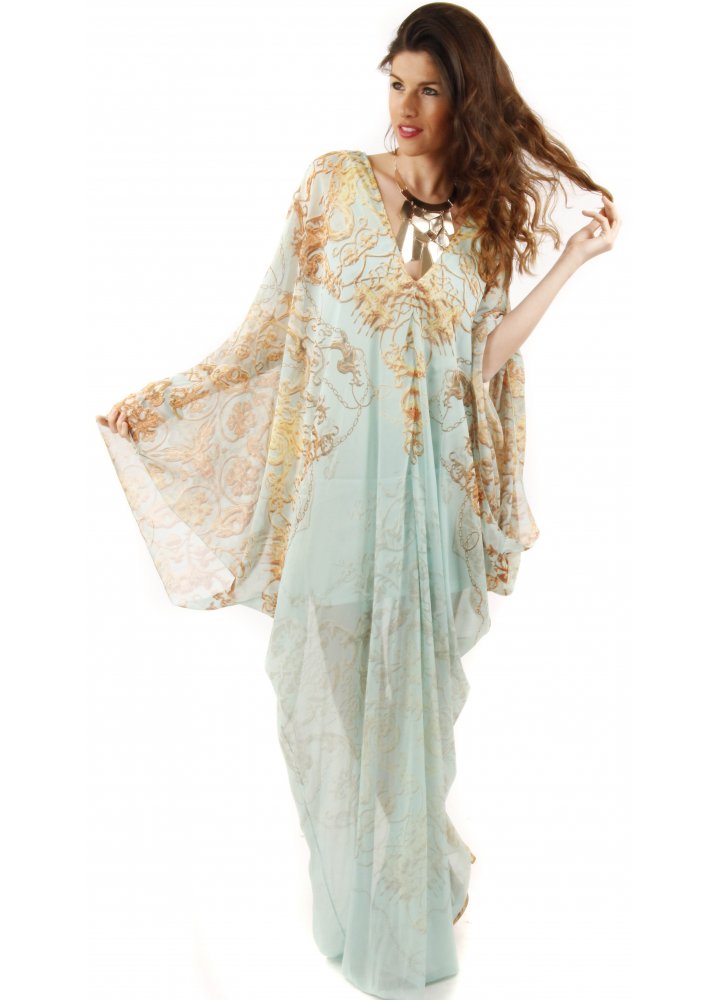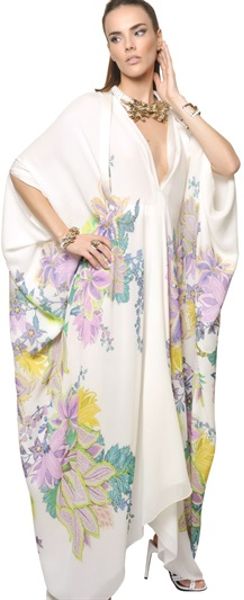Silk Kaftan Dress Biography
Source(google.com.pk)
A kaftan or caftan is a variant of the robe or tunic, versions of which have been worn by several cultures around the world for thousands of years. The kaftan is often worn as a coat or overdress, usually reaching to the ankles, with long sleeves. It can be made of wool, cashmere, silk, or cotton, and may be worn with a sash. The caftan is of ancient Mesopotamian origin.
Through its dissemination and evolution, the kaftan has acquired different styles, purposes, and names depending on the culture. In many regions with a warm climate, the kaftan is worn as a light-weight, loose-fitting garment. The kaftan has served as a symbol of royalty in some cultures and as a symbol of marriage in others during some parts of history.
Ottoman kaftan: Kaftans were worn by the Ottoman sultans in the Ottoman Empire. The decorations, including the colours, patterns, ribbons, and buttons, indicated the rank of the person to whom they were presented. From the 14th century through 17th centuries, textiles with large patterns were used. The decorative patterns on the fabrics became both smaller and brighter in the late 16th and in the 17th centuries. By the second half of the 17th century, the most precious fabrics were those with 'yollu': vertical stripes with various embroideries and small patterns, the so-called "Selimiye" fabrics.
Most fabrics manufactured in Turkey were made in Istanbul and Bursa, but some textiles came from as far away as Venice, Genoa, Persia (Iran), India and even China. Kaftans were made from velvet, aba, bürümcük (a type of crepe with a silk warp and cotton weft), canfes, çatma (a heavy silk brocade), gezi, diba (Persian), hatayi, kutnu, kemha, seraser (Persian) (brocade fabric with silk warp and gold or silver metallic thread weft), serenk, zerbaft (Persian) tafta (Persian). Favoured colours were indigo blue, kermes red, violet, pi?mis ayva or "cooked quince", and weld yellow.
The Topkapi Palace Museum in Istanbul possesses a large collection of Ottoman kaftans and textiles.
Moroccan Berber kaftan: In Morocco kaftans are in general worn by women, the word kaftan in Morocco is commonly used for one piece dress and there are typical versions of Moroccan kaftans called Takshita, Djellaba, etc. They are composed of two or more pieces plus a belt. Kaftans can be worn on both casual and extremely formal occasions, depending on the materials used.
Moroccan kaftans for men exist; this dress actually was masculine in the beginning, the Almohad used kaftans as the dress for males, and many Moroccan designers nowadays have kaftans for men among their collections. They are dedicated for special celebrations like wedding ceremonies or religious festivals.
The Moroccan kaftan results from the development of medieval dresses from Morocco and Al-Andalus like the masculine dress Merlota/Melota, so kaftan-making is an old industry in Moroccan medinas of handcraft and textile production.
West African kaftan: n West Africa, a kaftan is a pullover robe. Kaftans are worn by both men and women. In West Africa, the female robe is called a kaftan, and the male robe is called the Senegalese kaftan.
A Senegalese kaftan is a pullover men's robe with long bell sleeves. In the Wolof language, this robe is called a mbubb and in French it is called a boubou. The Senegalese caftan is an ankle length garment. It is worn with matching drawstring pants called tubay. Normally made of cotton brocade, lace, or synthetic fabrics, these robes are common throughout West Africa. A kaftan and matching pants is called a kaftan suit. The kaftan suit is worn with a kufi cap. Senegalese kaftans are formal wear in all West African countries.
Western kaftan: The kaftan was reintroduced to the West in Russia in the 1890s when Alix of Hesse wore the traditional Russian kaftan during her coronation. This traditional kaftan resembled the ones worn by Ottoman sultans and contrasted from the tight-fitting dresses with corsets common in England at that time.
The kaftan slowly gained popularity for its exoticism and as a form of looser-fitting clothing. French fashion designer Paul Poiret further popularized this style in the early 20th century.
In the 1950s, fashion designers such as Christian Dior and Balenciaga adopted the kaftan as a loose evening gown or robe in their collections.[5] These variations were usually sashless.
American hippie fashions of the late 1960s and the 1970s often drew from ethnic styles, including kaftans. These styles were brought to the United States from people who journeyed the so-called "hippie trail". African-styled, kaftan-like dashikis were popular, especially among African-Americans. Street styles were appropriated by fashion designers, who marketed lavish, Moroccan-style kaftans as hostess gowns for casual at-home entertaining.
Diana Vreeland, Babe Paley, and Barbara Hutton all helped popularize the caftan into mainstream western fashion. Into the 1970s, Elizabeth Taylor often wore kaftans designed by Thea Porter. In 1975 during her second wedding to Richard Burton, she wore a caftan designed by Gina Fratini. More recently, Jessica Simpson was often photographed wearing kaftans during her pregnancy in 2011.[4] American fashion editor André Leon Talley has also worn kaftans designed by Ralph Rucci as one of his signature looks.
Other regional variations:
Persian: Persian robes of honor were commonly known as khalat or kelat.
Jewish: Chassidic Jews adopted a silky robe (Bekishe) or a frock coat (kapoteh) from the garb of Slavic nobility. The term kapoteh may originate from the Spanish capote or possibly from "kaftan", via Ladino. Sephardic Jews in Ottoman or Muslim lands wore a kaftan like their neighbors. The term "Kapote" is also used in Morocco.
Southeast Asian: In South East Asia, kaftans are often worn as cool, casual hot weather attire. Hand-drawn, hand-painted batik fabric is often used.










No comments:
Post a Comment